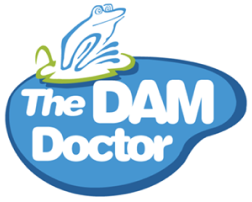Aquatic Weed Profile – Salvinia
Scientifice name – Salvinia Molesta
Other names – Giant Salvinia, Aquarium Watermoss, Kariba Weed
The one, the only, Salvinia. There are several species native to other parts of the world (America, Asia, Europe), but Salvinia Molesta (native to Brazil) is the only species to be established in Australia. Thank heavens, as it is definitely a dam problem. Originally imported for the aquarium trade it took hold in Australia in the 1950’s. A free floating aquatic fern that starts out life as a pair of oval shaped leaves roughly 12mm wide. As it matures the roots start to resemble wet hairs, and the leaves (now multiple pairs on a common stem) are covered with stiff water repellent (hydrophobic) hairs, and will become thick, folding at the mid-rib. It doesn’t flower, reproducing via vegetative means. Or, in layman’s terms, grows from bits of itself.
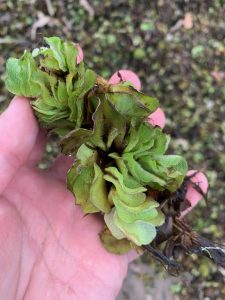
It is a Weed of National Significance, and in Queensland it is a Category 3 restricted plant under the Biosecurity Act 2014. Why? Well, like I already said, it is a dam problem. Left unchecked infestations will form mats covering the entire surface of a waterbody, and it can do it quickly. Preferring warmer temps, 20°C-30°C (but can survive in as high as 43°C), and in nutrient rich, slow moving or still water, Salvinia can double in volume every 2-3 days.
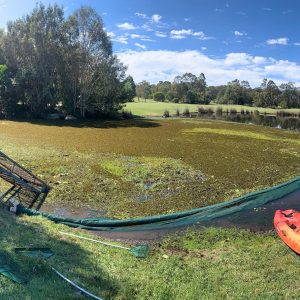
Once formed the mats will cause havoc for just about any waterbody, no matter its intended purpose. The multilayered plants prevent exchange of air, and can reduce oxygen levels in the water, creating, among other things, algal blooms and fish kills. They interfere or prevent recreational activities such as swimming, boating and fishing. Salvinia displaces native aquatic plants, discourages or prevents birds and native wildlife from accessing the waterbody, diminishing the natural beauty and appeal of the waterbody. The roots and vegetation wreak havoc on irrigation systems, slowing down pump efficiency (if they don’t clog them entirely) and blowing out costs. Livestock have restricted access, and are often unwilling to drink from heavily infested waterbodies. In summer, the hydrophobic upper leaves can have transpiration rates up to 4 times higher than expected evaporation.
As well as effecting water quality, and availability heavy infestations can create ideal breading grounds for mosquitoes and other nasties, did I mention that it’s a dam problem?
So how do you get rid of Salvinia? Luckily, it’s not all bad news. There are several controls available to manage infestations, I’ll go into them briefly below.
Manual Removal
For primary infestations (juvenile leaves that don’t cover the whole waterbody), or smaller dams and ponds a scoop can be used to manually remove any offensive materials. For larger dams or secondary and multi-layered infestations then more advanced techniques may be required, such as running boom nets, and using excavators or harvesters. Once the material is removed onto the bank it recommended to allow the material to dry and then give it a Viking burial (burn it), to prevent reinfestation or reintroduction. Manual removal can be problematic as the nature of the plant means any fragments left behind can reproduce, resulting in the infestation springing back the next time the mercury pushes north of 20°C.
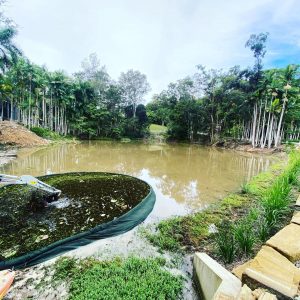
Aquatic Herbicide Spraying
Nuke it with some chemicals. Obviously chemical control is tricky as some herbicides can be unsafe for fish, irrigation, livestock watering, human consumption, or have withholding periods for any of these activities (orange oil can be effective against primary infestations as a natural environmentally friendly option). If you do go down this route, please be aware that spraying chemicals or herbicides into water bodies may require a licence in your area, so make sure to contact the relevant governmental departments prior to spraying. Also, not to mention making sure to check all labels and available safety data sheets to make sure you get the right mix, and have the appropriate PPE. You don’t want to do yourself, desirable plants, fish, or wildlife a mischief. Herbicide is rarely a one and done scenario. Most sprays will require ongoing applications.
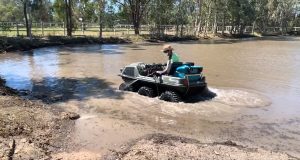
Waterbody Management
Micro manage your waterbody. Once the source of infestation has been identified, booms or mesh fences can be installed to help contain or control the spread of Salvinia. This can help to reduce time and money spent on spraying or manual removal.
As previously mentioned, Salvinia thrives in nutrient rich environments. Managing nutrient levels through aeration, promotion of beneficial bacteria, planting native replacement species, controlling or diverting erosion and runoff or effluent, and limiting livestock access to banks, will all help to slow the growth and spread of any Salvinia infestations.
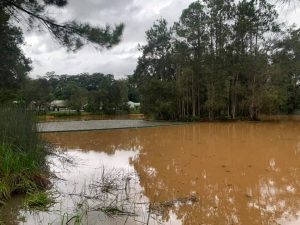
Biological Control
There is a biological control available for Salvinia – Cyrtobagous Salviniae aka Salvinia weevil. Since 1979 the CSIRO has been researching the suitability of the Salvinia weevil for controlling infestations across Australia. It is most effective in tropical areas where temperatures are between 20°C and 35°C, as reproduction will slow below 20°C and cease altogether in temperatures below 17°C. The weevil is native to Brazil and grows to about 2-3mm in length, and lives for roughly 6 months. The adult weevils feed on tips of the plant which help to suppress growth. However, the most damage is done by the larvae, that will burrow into the rhizome causing the plant to break apart, sink and die. Not all waterbodies are suitable for weevil introduction, factors such as sunlight, oxygen levels (over 40% dissolved oxygen desired), Salvinia cover (less than 70% cover desired), temperature (desired ranges as stated above), and risk of flooding or drying out will all influence the ability of a weevil population to become established. In suitable sites a population may become established in 1 to 3 years, in less suitable sites or temperate climates it may take over 5 years for the weevil to establish. It is recommended to release weevils in early spring as the temperatures when temperatures begin to warm up. Weevils are not recommended for sites where eradication is the goal, unless they are being used to thin Salvinia before employing another method (such as spraying). Ideally a population will create a balance between the weed and the weevils where both exist in small populations. If the Salvinia level drops too low then there is risk the weevils will die out and allow Salvinia to flourish and reinfest the waterbody. The weevils will not target other weed species (they are host specific), consequently as the weevils thin out Salvinia then monitoring is required to make sure other weed infestations are not forming in its place.
Sadly, this is one service that we do not currently offer. In Queensland and New South Wales, a permit is required to transport the weevil. If you live in these areas and are interested in accessing this control method, then we suggest you contact your local government Weeds or Environment Officer. They will assess your waterbody for suitability, arrange permits, and provide further advice for the proper introduction of the weevils.
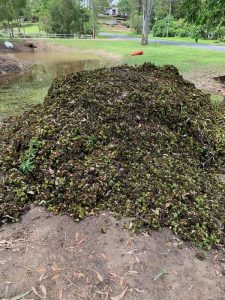
We use and recommend taking the “never-ending kitchen sink” approach. That is, throw as many as of them as you can at the infestation, as often as you can. Hit it hard, hit it early, and hit it often. Manual removal to remove the bulk of existing infestations, spot spraying to hit any remaining material, and managing the waterbody with aeration and reducing nutrient levels to help prevent reinfestation. Then monitor the waterbody so you can repeat any of these processes if new plants re-emerge. Controlling (preventing where possible) infestations of any weed at an early stage will significantly reduce the long-term time, money, and effort spent to eradicate them.
Sources:
https://www.daf.qld.gov.au/business-priorities/biosecurity/invasive-plants-animals/plants-weeds/wons
https://profiles.ala.org.au/opus/weeds-australia/profile/Salvinia%20molesta
https://www.daf.qld.gov.au/__data/assets/pdf_file/0003/65964/salvinia.pdf
https://weeds.brisbane.qld.gov.au/weeds/salvinia
CSIRO-
Weeds Australia-
